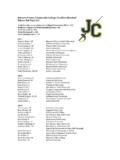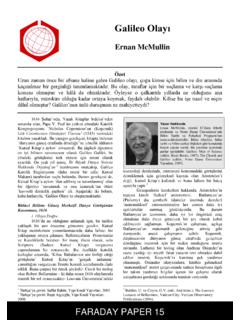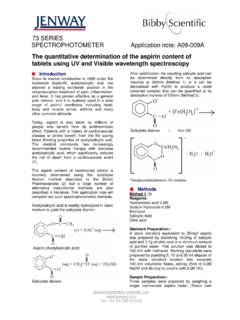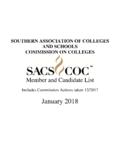Transcription of Estimating Population Size: Mark-Recapture
1 Biology 6C67 Exercise 3 BEstimating Population size : Mark-RecaptureParts of this lab adapted from General Ecology Labs, Dr. Chris Brown, Tennessee Technological university and Ecology onCampus, Dr. Robert Kingsolver, Bellarmine of the goals of Population ecologists is to explain patterns of species distribution andabundance. In today s lab we will learn some methods for Estimating Population size and fordetermining the distribution of Abundance: Mark-RecaptureMobile animals are usually simpler to define as individuals, but harder to count, because they tendto move around, mix together, and hide from ecologists. Quadrats are not a good approach withmobile animals because immigration and emigration in and out of the study site make it hard toknow what area the entire Population occupies.
2 For largemouth bass in a farm pond, you couldeasily draw a line around a map of the Population , but how would you define the edges of apopulation of house sparrows in your community? Although house sparrows tend to be moreconcentrated in towns and urban areas, they do not stop and turn back at the city limit sign. Forzoologists, a fuzzy definition of the space occupied by the Population often forces an arbitrarydesignation of the survey group, such as the " Population " of robins nesting on your campus in thespring. Knowing the number of animals in a designated study area is interesting, but we must bearin mind that the ecological Population is defined in terms of interactions among organisms of thesame species, and not by the ecologist's defining the individual and establishing the limits of the Population you wish to count, yournext task is to choose a counting method.
3 Arctic and prairie habitats lend themselves to accuratesurvey by aerial reconnaissance. This approach works poorly in forests, at night, underwater, or insoil habitats. If animals can be collected or observed in a standard time or collecting effort, youcan get an idea of relative abundance, but not absolute numbers. For example, the number ofgrasshoppers collected in 50 swings with an insect net through an old field community producesdata that could be used to compare relative abundance in different fields, but would not tell youhow many grasshoppers were in the estimates of absolute numbers, Mark-Recapture methods can be very effective. The first stepis to capture and mark a sample of individuals.
4 Marking methods depend on the species: birds canbe banded with a small aluminum ankle bracelet, snails can be marked with waterproof paint ontheir shells, butterflies can have labels taped to their wings, large mammals can be fitted withcollars, fish fins can be notched, and amphibians can have nontoxic dyes injected under the animals are immediately released as close as possible to the collection site. After givingthe animals time to recover and to mix randomly with the whole Population , the ecologist goes outon a second collecting trip and gathers a second sample of the organisms. The size of thepopulation can then be estimated from the number of marked individuals recaptured on thesecond Estimating Population size : Mark-RecaptureThe assumption behind Mark-Recapture methods is that the proportion of marked individualsrecaptured in the second sample represents the proportion of marked individuals in the populationas a whole.
5 In algebraic terms,This method is called the Lincoln-Peterson Index of Population the rearranged version of the general formula, notice that the smaller the number of recaptures,the larger the estimate of Population size . This makes good biological sense, because if thepopulation is very large, the marked animals you release into the wild will be mixing with a greaternumber of unmarked animals, so you will recapture a lower percentage of them in your 6C69 The Lincoln-Peterson method is fairly simple, and its calculations are straightforward, but it doesdepend on several assumptions. Violating the conditions of the Lincoln-Peterson model canseriously affect the accuracy of your estimate, so it is very important to bear these assumptions inmind as you interpret your results:1.
6 Individuals with marks have the same probability of survival as other members of thepopulation. It is important to choose a marking method that does not harm your animal. If apredator used your paint marks to locate and capture marked turtles at a higher rate thanother turtles, your number of recaptures would be lower, and the estimate would therefore betoo Births and deaths do not occur in significant numbers between the time of release and thetime of recapture . If marked individuals die and are replaced with newborns, then you willrecapture few or no marked individuals, and your estimate will be too high. This is not a largeconcern in studies of box turtles, but can significantly affect estimates for rapidly Immigration and emigration do not occur in significant numbers between the time of releaseand the time of recapture .
7 If marked individuals leave the study area and new unmarkedindividuals come in to replace them, you will get fewer recaptures than the equilibriumpopulation size would lead you to expect. To think about this another way, the real populationcovers a much larger area than the habitat you thought you were Marked individuals mix randomly with the Population at large. If your marked turtles do notmove among unmarked turtles, and you recapture them near the place you released them,then recaptured turtles may be overrepresented in your second sample, driving down yourpopulation Marked animals are neither easier, nor harder, to capture a second time. If marking an animalfrightens it so that it hides from you a second time, then recaptures will be underrepresentedin a second sample.
8 If animals become tame and are easier to recapture , then the oppositeerror is marks do not come off of your marked organisms. Invertebrates molt and shed marks ,mammals can wriggle out of their collars, and many things can happen to obscure yourmarks. If this happens, recaptures will be undercounted, and your estimate will be too your progress:A biologist nets 45 largemouth bass from a farm pond, tags their fins, and releases themunharmed. A week later, she nets 58 bass from the pond, including 26 with tags. Based on theLincoln-Peterson index, estimate the number of bass in the Estimating Population size : Mark-Recapture7. recapture rates are high enough to support an accurate estimate.
9 The Lincoln-Petersoncalculation tends to overestimate the Population size , especially if the number of recaptures 7 is often violated, because it is difficult to generate sufficient recaptures in largepopulations. To provide a better estimate, ecologists sometimes use multiple marks andrecaptures and the Schnabel index to estimate Population size : ===miimiiiRCMN11where Mi = the total number of previously marked animals at time i, Ci = the number caught attime i, and Ri = the number of marked animals caught at time an example, suppose we caught and marked 100 animals in our first sample, captured 85animals (15 marked and 70 unmarked) in a second sample, and then captured 105 animals (25marked and 80 unmarked) in a third sample.
10 We would then have the following:iCiRiNew markedMi1100010002851570100310525-170 Note that Mi at time 1 is zero; this happens because we start this sampling with no markedanimals. For each subsequent time period, Mi is simply the sum of all previous values in the Newmarked column. From the above, we can estimate Population size as:659402635025150)105*170()85*100()100* 0(==++++=NNote that had we sampled only two times, our Population size estimate would be 567, so thisvalue is dependent on the number of samples Example of Schnabel Index CalculationBiology 6C71 Lab Exercise 3B: Mark-Recapture of Pinto BeansResearch QuestionHow do Population estimates using Mark-Recapture techniques compare to the true populationsize?





